Santiaguiño do Monte
Archaeological site dating back to the Iron Age (3rd century BC) commonly known as the place the apostle chose to preach the gospel. The compound is comprised of three unique elements:
The hermitage pre-dates Archbishop Rodrigo de Luna (15th century), a great driver of pilgrimages to Padrón whose shield is on the lintel of the east door. The façade notably contains a relief with the scene of the apostle baptising the she-wolf queen Lupa. Inside, there is only one nave with a small altar dominated by the stone image of Saint James, a piece that is curiously worn down from centuries of exposure to rituals in honour of the saint, including touching and embracing the apostle’s figure as a sign of devotion.
The Santiaguiño hermitage is currently only open during the novena and the Santiaguiño do Monte pilgrimage on July 25.
The font is a place of cleanliness, purification, and forgiveness of sin. That is how it was viewed at the apex of pilgrimages to Padrón. Popular tradition holds the belief that this is where the grotto where the apostle hid from his persecutors is located. It is also said to be the place where he tapped his staff three times to get water to spring out and quench the thirst of a gentile woman.
Ten rocks make up an ensemble crowned with the figure of the apostle preaching on a pedestal. There are a number of crosses engraved in front as well as an inscription with several interpretations including “Alms for James the Great” and “Alms for Jesus and Mary.” The rock above is crowned with a stone cross dating back to sometime before the 17th century. The monument also has a number of stairs where pilgrims once knelt as they arrived. Then, they would thread their bodies through the three holes in the rocks known as hell, heaven, and purgatory.
Acceso
Easily accesible, on foot and car
Santiaguiño do Monte s/n
GPS: 42.738172, -8.6670843816205

